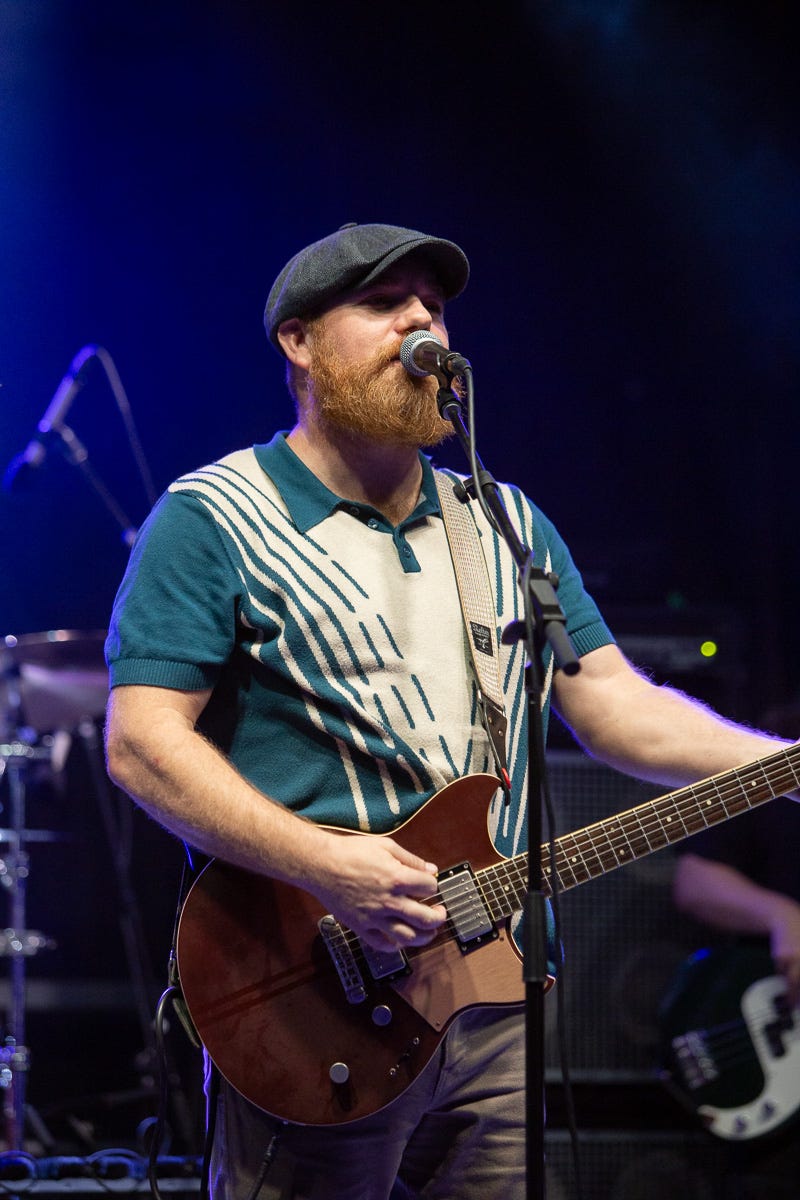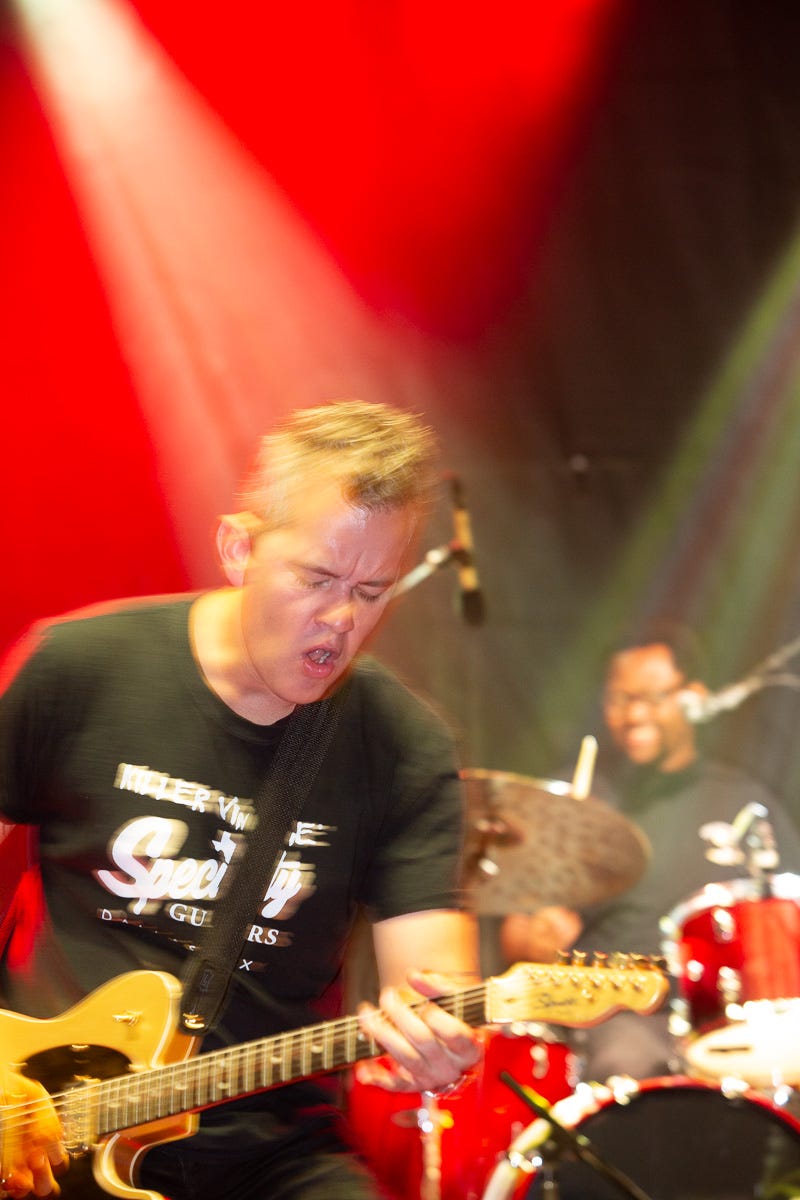I’m a child of the 60’s / 70’s rock explosion, I admit it. One of my first transgressions when I had access to official newspaper letterhead for The Greater Plaquemine Post (at my first teenage newspaper job in 1973) was to type up a request for a photo pass to cover the Joe Walsh / Charlie Daniels Band concert in Baton Rouge. I didn’t ask permission of my editor or anyone else. I did it at night, alone in the building. My desire to attend this ear-shredding 100db+ event in the brilliant Hollywood Bowl-like acoustics of Independence Hall (check out these posters!) coupled with my newfound status as local photographer…wait, was I going to become a white collar criminal?? I got the press pass and shot the show pushing my way to the stage. Earplugs were the last thing on my mind. Another decibel of tinnitus, anyone? My editor, Gary Hebert, loved getting feature-type photos and Ricky was buzzed to see his byline:
(Iberville South tearsheet, 1973 © Rick Olivier)
So me and rock concerts and photographs go waaay back. Half a century back. (Though I wouldn’t combine “Charlie Daniels” and “progressive” in the same sentence today.) If you need a soundtrack Walsh’s Rocky Mountain Way should suffice. Talk Box! Yeah, baby. Boy-o slide guitar really ruled back then, huh? Duane, Eric, Joe…
On-To the How-To
Oh, c’mon. You probably already have a Program mode slr that can shoot circles around my vintage Canon 5D MkIII (300K+ still going strong). Really, just put that Sony 400-megapixel dream machine on P and rock. You’ll need a telephoto lens to get in there and a normal-to-wide lens for horizontals. Telephotos for low-light should be as “fast” (let in more light, lower number) as possible, so an f2 lens is preferable to an f4 lens. This “wider” (lower #) aperture will give you less depth-of-field (zone of in-focus) so your focusing has to be spot-on. (If your camera/lens has it) Servo-Mode autofocus may produce more usable images since it speeds up internal focus in the lens. You’ll want to set your ASA, er, I mean ISO, to the highest setting that produces usable images not ruined by digital noise. Personally, I like just a bit of grain-looking noise in my low-light pictures and Lightroom has good noise-reduction in post processing if you don’t.
If shooting in Program is for chumps and you want to live dangerously try shooting on Manual. I only use Program in dappled/changing daylight when changing light is cumbersome to follow and match to “good” exposures. Plus, with digital cameras you get a freakin’ HISTOGRAM!
Jeez, you know what we would’ve given for a histogram thirty years ago? Uh, make that forty years ago. If you’re not yet hip to reading your histogram (graph of tones in the image) maybe I’ll cover that in another post. For example: you shoot a picture of Beyonce’ (wait, you DIDN’T sign the non-disclosure? good for you!) at 1/250 and f2 at ISO 3200 and look at the image on-camera. Her sparkly cat-suit is nice but you can’t see the actual diamonds. They’re too bright. Reduce the exposure (higher shutter speed) to 1/1000, shoot another and look again. Too bright still? Stop-down (higher number) the aperture to f4, shoot and look. Nice, you can see the sparkles, texture, and it’s sharp. Groovy.
More Cowbell, More Manual
Wait, shadows blocking up on you? Yeah, that’s high contrast light and your nowadays rock/country/hiphop stars love shading their eyes with caps (but don’t knock it until you’ve been up there, the lighting makes it almost impossible for them to see the audience.)
(Marc Broussard at Abita Fall Fest, ©2023 Rick Olivier)
Even when you nail the exposure and focus you still may crave more information in your image. Back in ‘73 I was happy just to get ANY usable image at ASA 1600, the classic “Tri-X pushed two-stops” but today we got gadgets and gizmos to help us light up the night. With digital you basically have to expose for the highlights. I’m probably at 1/500 and f4 at ISO 3200 in the shot above which gives me good sharpness, color, and texture, but the shadows are real horrorshow. Time to break out the name-brand or other (Yongnuo & company) flash. Don’t fret if all you have is the five-dollar Vivitar 283 you bought on ebay. Fret because the high sync voltage of these old tank-like flashes may fry your posh new-camera hot shoe connections (though they’re fine for old film cameras, etc). See, you do need a Yongnuo flash after all. Rumor is that Yongnuo and other Canon/Nikon/Sony competitor knock-off flash units were so good that Canon et al just bought the company and continue to make and sell the knockoffs. A bird in hand…
Flash Gordon vs. Ming The Merciless
So the basic trick with fill-flash (where your simply adding a bit of light to a correct available light exposure) is that less-is-more. If all you have is an older flash unit you should avoid “auto” mode on the flash and try 1/4th power for starters. If that’s still too much fill-flash and it’s overpowering your beautiful shot, go down to 1/8 or 1/16th and have a look. If you have a newer high-tech flash you may be fine just setting the camera AND flash to Program. (See, you didn’t need to read this post after all, ya cheater ;-) But if, like me, you’re macho and shooting on Manual, you can use the fractional setting above on your flash to just add a little kiss of light into those nooks and crannies:
(Marc Broussard at Abita Fall Fest, ©2023 Rick Olivier
The idea is to simply illuminate the hidden shadow areas without affecting the midtones and highlights. This is where fractional (1/4th, 1/8th, etc.) power settings are your best friend. If all you have is an old-timey flash without fractional power you can lower the output by setting the flash ISO higher, thereby tricking the flash into throwing less light. Now, having said that, there is one caveat: your camera shutter has a maximum sync speed for synchronizing with the flash. Usually it’s 1/250 or 1/160th (don’t complain, it used to be 1/60th backintheday) so you can’t shoot with flash at shutter speeds beyond the maximum sync speed. It’s OK, use Image Stabilization if your camera/lens has it. If not, brace your elbows into your tummy and exhale. The flash burst is much faster than your 1/125 shutter and will freeze the shadow part of the image. But wait, if you order NOW, there’s more! Most new brand-matched flash units have a high speed sync setting. You can set the flash to high speed sync and bump up the shutter speed for pure concert flash photo perfection. Depending on your white balance / lighting color, you may also enjoy the cooling-down of shadow areas, too, like in the image above. Incidentally, Marc Broussard is a king of the blue-eyed soul music that’s still popular down here below I-10. I shot one of his album covers a few years ago and he’s one cool Cajun with a passel o’ younguns, brah. And I really dig parlor guitars (above).
Mistake?! No, I Did That On Purpose
So now that you’re out there in the front row shooting your heart out and driving the performers crazy with your pop-pop-pop flash, don’t forget to make a few mistakes and try some crazy stuff once you’ve “covered” the concert. You might get lucky!
When I was first making adjustments to my fill flash I must have accidentally changed the shutter speed to 1/20th which is way too slow to get a sharp image with a telephoto. How do I know this? By looking at the metadata of the image in my editing program (Adobe Lightroom):
True, you’ll never get a sharp telephoto image at a shutter of 1/20 but, dang, this was one of my favorite images from the entire shoot. The slow shutter speed captures the energy of a big-@ss rock spectacle. I also like the saturated red background and how the back spotlight anoints this musician from on high. Marc’s band is world-class and both lead guitarists sound like Nashville Cats (Wow, Sal Yanovsky used a thumb pick. How ‘bout that…) so I was pleased to capture some of that in a “mistake” image. And notice how his face (shadow) is frozen sharp (the flash) and everything else is shaking. We used to call this shake ‘n bake, using a flash with a slow shutter speed. You’ll get a lot of unusable images but when the accidents work, it can be sublime. Never fear, just tell anyone who asks you “did this on purpose” because you’re an artist, not a trench-warfare infantry soldier in the Great Concert Image War.
Got an Evening Concert Question? Leave in the comments. Hell, leave any comment and it’ll make you part of a Very Elite Group. I plan to make these “How To Shoot” posts a regular thing for those hoping to woodshed their chops in Photography For Fun And Profit. Stay tuned…
Cheers, my droogies ;-) R.










Great images here. Live concerts I know are very difficult to photograph. Thank you for sharing! 🤗
haha bro.. can we exchange notes or what ! Damn near fell over on findin yer ‘stack.. but you had me at ‘cajun’ eh !🦎🏴☠️